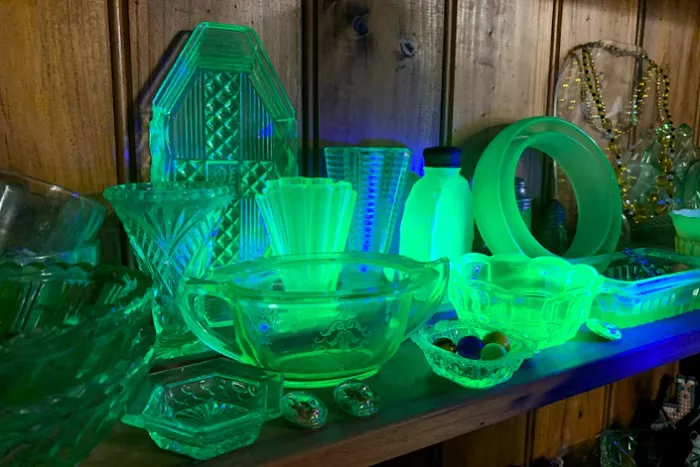In a small antique shop nestled in North Queensland, the Fleming family has cultivated a unique legacy of collecting uranium glass, a passion that began with the opening of their business in 1970. This unusual collection of glowing glassware has not only captivated the public but also sparked an enduring fascination with radioactive trinkets.
Tristan Fleming, the owner of the Townsville-based antique store, explained that uranium glass was once commonly used in everyday objects such as drinking vessels and mixing bowls. The glass, which was often produced during the late 19th and early 20th centuries, contained uranium to give it a distinctive green hue. Under ultraviolet (UV) light, this subtle tint transforms into an unmistakable bright green glow, attracting collectors and curious visitors alike.
“They were made in drinking vessels and mixing bowls and everything you could possibly imagine,” Fleming remarked. “It is a radioactive substance, and if you put it near a Geiger counter, it will go off.”
While the glowing effect remains the primary draw for collectors, Fleming noted that the popularity of uranium glass has surged in recent years, particularly among younger people. Many now visit the store with UV flashlights in hand, eager to uncover the glow of these nostalgic pieces. “I am more than happy for you to scan everything in the shop,” Fleming said. “Generally, if it’s uranium glass, we will have a note on the tag.”
In the past, identifying uranium glass was challenging before black lights became widely available. During the early days of the Fleming family’s antique business, the value of uranium glass was similar to that of other green-colored glass, such as Depression glass. However, the allure of uranium glass and its rarity today has pushed its value up significantly.
Fleming advises prospective collectors to use an A365 black light to achieve a brighter glow when examining items. “Black lights were a fluorescent bulb … that was really the only way,” he explained.
Although the radiation emitted by uranium glass is minimal and generally considered safe, experts caution collectors to exercise care when handling the items. Kristyn Bullen, senior preventive conservator at the Powerhouse Museum, oversees hazardous materials in the museum’s collection, which includes uranium glass. “Most of our uranium glass is on open shelving displays … so it is safe for people to be around and handle,” she stated. “However, they are radioactive, and there is a level of radiation that people are exposed to every time they touch the object.”
Bullen clarified that the radiation levels from most uranium glass objects are lower than 10 microsieverts per hour, a level considered safe given that the annual radiation dosage limit is 1,000 microsieverts. However, she advised against prolonged exposure and discouraged drinking from uranium glassware due to the potential health risks associated with alpha radiation.
While uranium glass is safe to handle in short bursts, Bullen emphasized the importance of caution. “I wouldn’t be drinking out of them either, because they usually do have alpha radiation, which is quite damaging when it gets inside the body,” she said.
Uranium glass enthusiasts are not confined to North Queensland. Veronica Farina, a school teacher and member of a nationwide Facebook group dedicated to uranium glass collectors, explained how her collection began by accident. “My son bought me a posy vase from an antique shop,” she said, “and from there, it just grew into a shared family hobby.”
Farina’s family now enjoys exploring second-hand shops with flashlights in search of new additions to their growing collection. “It becomes kind of addictive,” she remarked, reflecting the increasingly popular trend among collectors.
The production of uranium glass ceased during World War II, as the United States prioritized uranium resources for the Manhattan Project, which aimed to develop atomic bombs. According to Tristan Fleming, this shift in demand made uranium glass less economically viable to produce. “After that, it just became more trouble than what it was worth to get the uranium,” he said.
Today, uranium glass is celebrated as a piece of history, offering collectors a glimpse into the past and a reminder of the fascinating intersection of antique craftsmanship and the atomic age.

